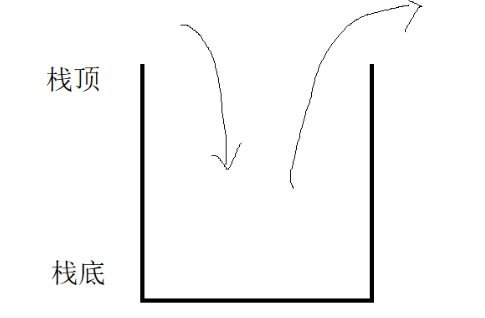目录
栈(后进先出)
是⼀种特殊的线性表,其只允许在固定的⼀端进⾏插⼊和删除元素操作。进⾏数据插⼊和删除操作
的⼀端称为栈顶,另⼀端称为栈底。
压栈:栈的插⼊操作叫做进栈/压栈/⼊栈,入数据在栈顶。
出栈:栈的删除操作叫做出栈。出数据也在栈顶。

底层结构是由数组实现的,相对来说数组在尾结点插入快
逻辑结构和物理结构都是线性的
栈的实现
头文件
#pragma once
#include<stdio.h>
#include<stdlib.h>
#include<assert.h>
#include<stdbool.h>
//定义栈的结构
typedef int STDataType;
typedef struct Stack
{
STDataType* arr;
int top;//有效数据个数
int capacity;//容量
}ST;
//初始化
void StackInit(ST* ps);
//栈是否为空
bool STEmpty(ST* ps);
//入栈----栈顶
void StackPush(ST* ps, STDataType x);
//出栈----栈顶
void StackPop(ST* ps);
//出栈顶数据
STDataType StackTop(ST* ps);
\ No newline at end of file
STDataType StackTop(ST* ps);
//获取栈中有效元素个数
int StackSize(ST* ps);
//栈是否为空
bool STEmpty(ST* ps);初始化
//初始化
void StackInit(ST* ps)
{
assert(ps);
ps->arr = NULL;
ps->top = ps->capacity = 0;
}使用前先调用StackInit初始化栈,然后才能进行入栈等其他操作,否则可能会导致未定义行为。
入栈

//入栈----栈顶
void StackPush(ST* ps, STDataType x)
{
if (ps->top == ps->capacity)
{
//增容
int newCapacity = ps->capacity == 0 ? 4 : 2 * ps->capacity;
STDataType* tmp = (STDataType*)realloc(ps->arr, newCapacity * sizeof(STDataType));
if (tmp == NULL)
{
perror("realloc");
exit(1);
}//空间申请成功
ps->arr = tmp;
ps->capacity = newCapacity;
}
ps->arr[ps->top++] = x;
}- 首先检查栈是否已满(
ps->top == ps->capacity) - 如果栈满,则进行扩容操作:
- 初始容量为 0 时,扩容到 4 个元素
- 否则,按照 2 倍容量进行扩容
- 使用
realloc重新分配内存空间 - 处理内存分配失败的情况(打印错误并退出程序)
- 将新元素
x放入栈顶位置(ps->arr[ps->top]) - 栈顶指针
top自增,指向新的栈顶位置
注意:
- ps指针不为空,一般断言一下。
- 栈结构
ST已经正确初始化 STDataType已经定义(通常是某种基本数据类型)
bool 判空
//栈是否为空
bool STEmpty(ST* ps)
{
assert(ps);
return ps->top == 0;
}为空则返回true,非空则是false
出栈----栈顶
//出栈----栈顶
void StackPop(ST* ps)
{
assert(!STEmpty(ps));
--ps->top;
}- 效率高,时间复杂度为 O (1)
- 实现简洁,通过移动栈顶指针而非真正释放内存来 "删除" 元素
注意
- 该函数依赖
STEmpty函数来判断栈是否为空,需要确保STEmpty已正确实现 - 出栈操作只是逻辑上移除元素(移动栈顶指针),并未真正释放内存,这是栈实现的常见做法
- 调用前应确保栈不为空,否则
assert会触发程序中断
出栈顶元素,元素不会删除
//出栈顶数据,元素不会删除
STDataType StackTop(ST* ps)
{
assert(!STEmpty(ps));
return ps->arr[ps->top - 1];
}
注意:
- 栈顶指针
top指向的是下一个可以插入元素的位置,所以当前栈顶元素的索引是top - 1 - 仅仅返回元素值,不修改
top指针,因此元素不会被 "删除" - 依赖
STEmpty函数判断栈是否为空,需要确保该函数已正确实现
获取栈中有效个数
//获取栈中有效元素个数
int StackSize(ST* ps)
{
return ps->top;
}- 直接返回栈顶指针
top的值作为栈中有效元素的个数 - 这是因为栈的实现中
top指针恰好表示了下一个可以插入元素的位置,同时也等于当前栈中元素的数量 - 时间复杂度为 O (1),效率极高
销毁栈
void StackDestroy(ST* ps)
{
assert(ps);
free(ps->arr); // 释放底层数组内存
ps->arr = NULL; // 避免野指针
ps->top = ps->capacity = 0; // 重置状态
}源文件操作
#include"Stack.h"
void test1()
{
ST st;
StackInit(&st);
StackPush(&st,1);
StackPush(&st, 1);
StackPush(&st, 2);
StackPush(&st, 3);
StackPush(&st,4);
StackPush(&st, 4);
StackPush(&st, 5);
/*StackPop(&st);
StackPop(&st);
StackPop(&st);
StackPop(&st);
StackPop(&st);
StackPop(&st);
StackPop(&st);*/
/*while (!STEmpty(&st))
{
int top = StackTop(&st);
printf("%d ", top);
StackPop(&st);
}*/
int size = StackSize(&st);
printf("%d\n", size);
}
int main()
{
test1();
return 0;
}用栈实现递归*
#include <stdio.h>
#include <stdlib.h>
#include <assert.h>
// 定义栈结构
typedef int STDataType;
typedef struct Stack {
STDataType* arr;
int top; // 栈顶指针,指向栈顶元素的下一个位置
int capacity; // 容量
} ST;
// 栈的基本操作
void StackInit(ST* ps) {
assert(ps);
ps->arr = NULL;
ps->top = ps->capacity = 0;
}
void StackPush(ST* ps, STDataType x) {
assert(ps);
if (ps->top == ps->capacity) {
int newCapacity = ps->capacity == 0 ? 4 : 2 * ps->capacity;
STDataType* tmp = (STDataType*)realloc(ps->arr, newCapacity * sizeof(STDataType));
if (tmp == NULL) {
perror("realloc");
exit(1);
}
ps->arr = tmp;
ps->capacity = newCapacity;
}
ps->arr[ps->top++] = x;
}
void StackPop(ST* ps) {
assert(ps);
assert(ps->top > 0);
ps->top--;
}
STDataType StackTop(ST* ps) {
assert(ps);
assert(ps->top > 0);
return ps->arr[ps->top - 1];
}
int StackSize(ST* ps) {
assert(ps);
return ps->top;
}
void StackDestroy(ST* ps) {
assert(ps);
free(ps->arr);
ps->arr = NULL;
ps->top = ps->capacity = 0;
}
// 用栈模拟递归计算n的阶乘
int Factorial(int n) {
if (n < 0) return -1; // 处理异常情况
ST stack;
StackInit(&stack);
// 1. 模拟递归调用过程:将所有需要计算的数值入栈
while (n > 1) {
StackPush(&stack, n);
n--;
}
// 2. 模拟递归返回过程:从栈顶开始计算
int result = 1;
while (StackSize(&stack) > 0) {
result *= StackTop(&stack);
StackPop(&stack);
}
StackDestroy(&stack);
return result;
}
int main() {
int num = 5;
int result = Factorial(num);
printf("%d的阶乘是: %d\n", num, result); // 输出:5的阶乘是: 120
return 0;
}
队列(先进先出)
只允许在⼀端进⾏插⼊数据操作,在另⼀端进⾏删除数据操作的特殊线性表
⼊队列:进⾏插⼊操作的⼀端称为队尾
出队列:进⾏删除操作的⼀端称为队头

队列实现
头文件(基本操作):
#pragma once
#include<stdio.h>
#include<stdlib.h>
#include<assert.h>
#include<stdbool.h>
typedef int QDataType;
//队列结点的结构
typedef struct QueueNode
{
QDataType data;
struct QueueNode* next;
}QueueNode;
//队列的结构
typedef struct Queue
{
QueueNode* phead;
QueueNode* ptail;
//int size; //队列中有效数据个数
}Queue;
//初始化
void QueueInit(Queue* pq);
//销毁队列
void QueueDestroy(Queue* pq);
//入队——队尾
void QueuePush(Queue* pq, QDataType x);
//出队——队头
void QueuePop(Queue* pq);
//队列判空
bool QueueEmpty(Queue* pq);
//队列有效元素个数
int QueueSize(Queue* pq);
//取队头数据
QDataType QueueFront(Queue* pq);
//取队尾数据
QDataType QueueBack(Queue* pq);结构
//队列结点的结构
typedef struct QueueNode
{
QDataType data;
struct QueueNode* next;
}QueueNode;
//队列的结构
typedef struct Queue
{
QueueNode* phead;
QueueNode* ptail;
//int size; //队列中有效数据个数
}Queue;- 插入和删除操作效率高(队尾插入、队首删除均可在 O (1) 时间完成)
- 不需要预先分配固定大小的内存,动态性好
初始化
//初始化
void QueueInit(Queue* pq)
{
assert(pq);
pq->phead = pq->ptail = NULL;
//pq->size = 0;
}- 使用
assert(pq)确保传入的队列指针pq不为空,避免空指针操作 - 将队头指针
phead和队尾指针ptail都初始化为NULL,表示初始状态下队列为空 - 注释掉的
pq->size = 0用于初始化队列元素个数(如果保留size成员的话)
判空
/队列判空
bool QueueEmpty(Queue* pq)
{
assert(pq);
return pq->phead == NULL;
}入队----队尾
//入队——队尾
void QueuePush(Queue* pq, QDataType x)
{
assert(pq);
QueueNode* newnode = (QueueNode*)malloc(sizeof(QueueNode));
if (newnode == NULL)
{
perror("malloc fail");
exit(1);
}
newnode->data = x;
newnode->next = NULL;
if (pq ->phead!= NULL)//队列非空
{
pq->ptail->next = newnode;
pq->ptail = newnode;
}
else//队列为空
{
pq->phead = pq->ptail = newnode;
}
//size++;
}- 当队列为空时(
phead为NULL),新节点既是队头也是队尾 - 当队列非空时,将新节点链接到当前队尾节点(
ptail)的next,然后更新ptail指向新节点
出队----队头
//出队——队头
void QueuePop(Queue* pq)
{
assert(!QueueEmpty(pq));
if (pq->phead == pq->ptail)//只有一个节点,头尾都置为空
{
free(pq->phead);
pq->phead=pq->ptail = NULL;
}
else
{
QueueNode* next = pq->phead->next;
free(pq->phead);
pq->phead = next;
}
}
- 分两种情况处理:
- 当队列中只有一个节点时(
pq->phead == pq->ptail):- 释放该节点内存
- 将
phead和ptail都置为NULL,保持空队列状态
- 当队列中有多个节点时:
- 先保存头节点的下一个节点指针
- 释放头节点内存
- 更新
phead指向保存的下一个节点
- 当队列中只有一个节点时(
优势:
- 正确维护了队列的头指针和尾指针状态
- 避免了内存泄漏(释放了被移除节点的内存)
- 处理了队列从有元素变为空的边界情况
若包含size,size--保持数量一致
取队头队尾数据
//取队头数据
QDataType QueueFront(Queue* pq)
{
assert(!QueueEmpty(pq));
return pq->phead->data;
}
//取队尾数据
QDataType QueueBack(Queue* pq)
{
assert(!QueueEmpty(pq));
return pq->ptail->data;
}优势:
- 时间复杂度都是 O (1),效率很高
- 仅获取元素值,不会修改队列的结构和状态
- 依赖
QueueEmpty函数判断队列是否为空,保持了代码的一致性 - 符合队列 "先进先出" 的特性,分别提供了访问两端元素的接口
销毁
//销毁队列
void QueueDestroy(Queue* pq)
{
assert(pq);
QueueNode* pcur = pq->phead;
while (pcur)
{
QueueNode* next = pcur->next;
free(pcur);
pcur = next;
}
pq->phead = pq->ptail =NULL;
//pq->size =0;
}销毁队列是一个通用操作,即使队列为空(初始状态或已清空),也应该允许调用QueueDestroy,这样可以避免在调用销毁函数前还需要手动判断队列是否为空。
允许对空队列进行销毁
- 当队列为空时,
pcur初始为NULL,循环不会执行,直接重置phead和ptail - 当队列非空时,循环释放所有节点,最后重置指针